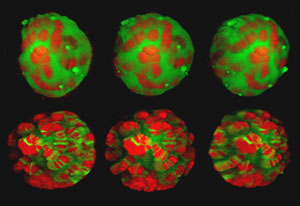
Hot Flies Produce Cool Results
ITHACA, N.Y., Sept. 25, 2006 -- Using multiphoton fluorescence microscopy, researchers have for the first time watched chromosomes change form to activate their genes to synthesize key proteins in fruit fly cells. The advance could be a significant step toward understanding the basic processes that underlie gene expression in living tissue.
The discovery was the result of cross-disciplinary collaboration between Cornell University applied physics professor Watt W. Webb, who pioneered the microscopy technique, and John Lis, the university's Barbara McClintock Professor of Molecular Biology and Genetics. Jie Yao, who recently earned his PhD at Cornell, initiated and facilitated the work.
"This technology will revolutionize the way we see gene expression in organisms," said Lis. "We're watching transcription in real time in living cells."
The team's experiments focused on gene regulatory mechanisms: specifically, what happens in a cell's nucleus when an external stimulus (heat) prompts specific genes to activate, and how those activated genes direct the production of proteins that protect the fly against the stress of heating.
Salivary glands of Drosophila (fruit fly) larvae contain giant polytene chromosomes whose characteristic banded structure is readily visible by light microscopy. Usually these chromosomes are visualized by breaking the nuclei and "spreading" the chromosomes in two dimensions. Using two-photon laser-scanning microscopy, these chromosomes can be examined in living salivary gland tissue in 3-D and in real time with similar high resolution. This image shows a series of optical sections where the DNA is stained with Hoechst (pseudo-colored red). (Image: Jie Yao/©Cornell University)
"Whenever a cell is stressed -- Bingo, it will produce proteins that will help the cell resist stress," said Webb, who is also the S.B. Eckert Professor in Engineering. The process is triggered by a molecule called heat shock factor (HSF), which interacts with genes to cue the synthesis of new proteins. But this well-known process had never been seen in living cells.
Yao used multiphoton microscopy (MPM) to image living salivary gland tissue of Drosophila (fruit flies). Unlike other methods, which lack penetrating power and can damage the specimen, MPM delivers crisp, clear images, even in thicker tissue samples like Drosophila salivary glands.
The research was ultimately possible thanks to the unique composition of the fruit flies' polytene cells -- giant, multistranded chromosomes with hundreds of sets of the genome instead of the usual two sets in conventional cells. This enlarges the usual nuclear dimensions by about 10 times, making them large enough to image the detail.
The results were stunning, the researchers said. "Within two weeks we had spectacular pictures," said Lis. The images included pictures of the genes (hsp70 genes) that protect flies from the effects of extreme heat. By cranking up the heat, the researchers could activate these genes, and by using fruit flies specifically bred to carry fluorescent proteins on HSF, they could watch the transcription factors in action.
"This is the first time ever that anyone has been able to see in detail, at native genes in vivo, how a transcription factor is turned on, and how it then is activated," said Webb.
Using another method that Webb engineered called fluorescence recovery after photobleaching, the researchers also discovered that HSF activators bind to hsp70 genes much longer than previously thought before being replaced with new HSFs, which raises new questions about the mechanisms of gene transcription.
The technique also may offer a new tool for researchers across the biological sciences. Webb said it marks the success of an interdisciplinary trend that offers new potential for researchers in a variety of fields.
"Interaction between the physical sciences and the life sciences is very powerful," said Webb. "And it's becoming more powerful as a tool for advancing our understanding of the life sciences."
Better understanding transcription in lower organisms will help understand the processes in higher organisms, Yao said. "We hope to push the limits to human cells. That's the goal in the next 20 years."
The research was described in the Aug. 31 issue of the journal Nature. For more information, visit: www.news.cornell.edu
Published: September 2006